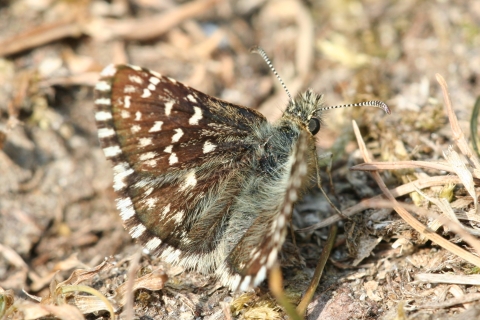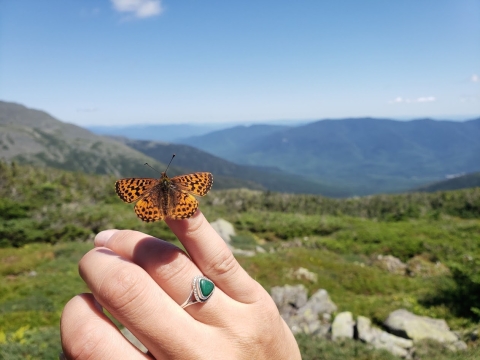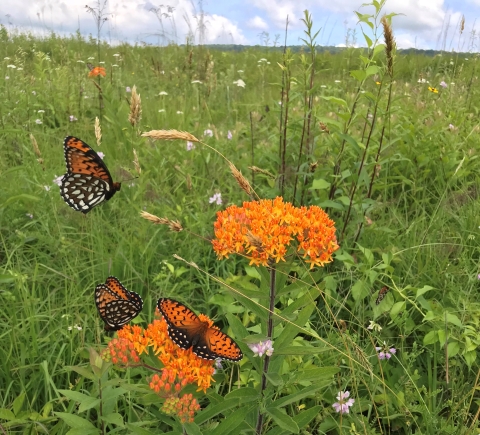Forget whatever assumptions you have about those small, fluttery insects with tissue-paper-thin wings: butterflies are tough.
Ever consider why one of the biggest construction-equipment companies in the world is named for a stage in a butterfly’s lifecycle? Or why the most popular tattoo in the U.S. is a butterfly? It’s because butterflies are symbols of perseverance and grit. We like to stop and smell the roses; young butterflies eat flowers for breakfast.
Some butterflies live atop New Hampshire’s Mount Washington, infamous for its dangerous weather. Some butterflies forage among spent shells in active artillery ranges, where they feel right at home. Some butterflies eat their own egg cases after hatching as larvae, their only meal before overwintering in the dirt.
But we’ve pushed these rugged little critters to their limits. Despite adaptations that allow them to endure extreme conditions, populations of numerous butterfly species are shrinking due to loss and fragmentation of their habitat by development and climate change climate change
Climate change includes both global warming driven by human-induced emissions of greenhouse gases and the resulting large-scale shifts in weather patterns. Though there have been previous periods of climatic change, since the mid-20th century humans have had an unprecedented impact on Earth's climate system and caused change on a global scale.
Learn more about climate change .
That’s why the U.S. Fish and Wildlife Service is working proactively with partners across the nation to change the trajectory for butterflies that are “at risk” of declining to the point where they need protection from the Endangered Species Act.
Here are a few of the butterflies we look up to and what we are doing to keep them going strong:
True frit
Species name: White Mountain fritillary (Boloria chariclea montinus) and White Mountain arctic (Oeneis melissa semidea)
What makes them tough: These two small butterfly species are found in the alpine zone atop the highest peaks in the Northeastern U.S. — New Hampshire’s White Mountains, including the 6,288-foot behemoth Mount Washington. Considered one of the most dangerous peaks in the U.S. because of its harsh, fickle weather, Mount Washington’s worst conditions rival those recorded in Antarctica. Winter-like storms can occur even in summer when butterflies are active.
Why they’re in trouble: The White Mountain fritillary and White Mountain arctic depend on a narrow habitat niche that’s vulnerable to trampling by hikers who wander off-trail and to changing conditions resulting from climate change. Warmer winters could mean less total snow accumulation on mountaintops. Warmer springs could mean the snow melts earlier in the season. Either scenario could lead to drier conditions that affect the plant communities these butterfly species depend upon as adults, larvae, or both.
What partners are doing to help: For more than a decade, New Hampshire Fish and Game has collaborated with conservation partners, including the U.S. Forest Service, Appalachian Mountain Club and the Service, to protect these butterflies, in part by learning more about them. We’ve partnered with the state to survey for butterflies to understand population trends, and to support a captive-rearing laboratory on top of Mount Washington. Here, scientists study the butterflies at each life stage to get a sense of what they need to survive and thrive.
At home on the range
Species name: Eastern regal fritillary (Argynnis (Speyeria) idalia idalia)
What makes them tough: Eastern regal fritillaries thrive amidst disturbance. The species’ habitats — prairies and fields with native warm-season grasses — need to burn periodically to prevent woody vegetation from taking over and to maintain an abundance of host and nectar plants. Because fire is also an important tool for the safe operation of military training installations (ammunition and woody debris can be a dangerous combination), the eastern regal fritillary has found a niche on an Army National Guard artillery range in Pennsylvania.
Why they’re in trouble: For thousands of years, the open habitats the eastern regal fritillary needs to survive were maintained naturally through wildfires and burns set by Native Americans to manage the landscape for hunting and other activities. As the landscape came to be dominated by mature forests, developed lands and networks of roads, populations of these non-migratory butterflies became isolated and began to blink out. Once found from New Brunswick to North Carolina, the eastern regal fritillary is now limited to a single location at the Fort Indiantown Gap National Guard installation in Annville, Pennsylvania.
Climate change threatens to further constrict its habitat. The fritillary’s caterpillars eat only violets; changes in temperature and moisture could impact bloom times and overall productivity of these native wildflowers.
What partners are doing to help: Since 1992, Fort Indiantown Gap has actively managed and conserved habitat for the eastern regal fritillary through prescribed burning and mowing, population surveys and an innovative partnership with ZooAmerica to propagate butterflies in captivity and release them at suitable sites. We’re working with the fort to develop a candidate conservation agreement for the fritillary — a formal, voluntary commitment to implement specific actions designed to remove or reduce threats to a species that is being evaluated for protection under the Endangered Species Act.
Frequent fliers
Species name: Monarch (Danaus plexippus)
What makes them tough: We marvel (rightly) at people who embark on long-distance thru-hikes like the 2,100-mile Appalachian Trail. We should marvel at monarchs, too: In the fall, these iconic, orange-and-black butterflies travel nearly 2,000 miles in months-long journeys to their overwintering grounds in the mountains of central Mexico and coastal California. In the spring, they hit the trail again, flying back to their breeding grounds, where they reproduce and die, leaving the next generation to complete the northward relay. These bugs don’t need maps, compasses or freeze-dried meals. They just follow their instincts to nectar.
Why they’re in trouble: For more than 20 years, communities and scientists have been tracking monarch populations and documenting the decline in the number of monarchs at overwintering sites. They attribute the decline to degradation and loss of breeding, migratory and overwintering habitat, whether from conversion of grasslands to agriculture, urban development, widespread use of pesticides, or far-reaching effects of climate change like drought.
What partners are doing to help: The Service and partners have stepped up proactive efforts to improve the monarch’s status across its range. We’re changing land management practices to support the species’ habitat and helping others do the same, including through the New England Pollinator Partnership.
A collaboration between the Service, the U.S. Department of Agriculture’s Natural Resources Conservation Service and the Xerces Society for Invertebrate Conservation, this budding initiative delivers technical and financial assistance to agricultural producers interested in implementing pollinator conservation practices on their land. From establishing wildflower meadows to developing ecosystem-based pest management strategies, the New England Pollinator Partnership program is meeting needs of pollinators like monarchs and agricultural producers across the region.
Lifting up butterflies
You can play a role in conserving butterflies and other pollinators where you live and recreate:
- Stay on the trail: Whether you’re summitting the highest peak in the Northeastern U.S. or taking a walk in a local park, stay on the trail to avoid unintentionally trampling habitat for wildlife big and small.
- Plant for pollinators: Whether it’s a planter on a balcony or raised beds in a yard, a garden of any size can nourish butterflies and other pollinators. Select a variety of nectar plants native to your region and make herbicides and pesticides your last option when battling weeds and pests.
- Report sightings: Sharing information about declining butterflies can help scientists conserve them. There are community science initiatives for both the White Mountain fritillary and the monarch that invite the public to report sightings. Even if you don’t catch sight of an at-risk butterfly, being on the lookout for these tough little bugs will make you appreciate their beauty and strength.
Learn more at: https://www.fws.gov/initiative/pollinators/how-you-can-help








